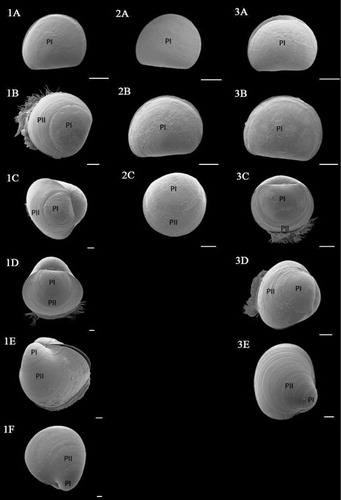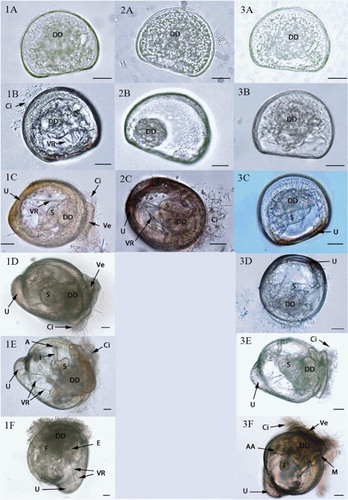Figures & data
![Figure 1 Diagram of experimental design, including treatments with two cryoprotectant solutions (10% ethylene glycol + 1% polyvinylpyrrolidone plus either 0.2 M or 0.4 M trehalose [final concentration]) and three freezing rates (0.5, 1 and 2 °C min−1) and control (no cryopreservation).](/cms/asset/24ce9d19-7e1f-4d58-94e5-86568f86d416/tnzm_a_914545_f0001_b.jpg)
![Figure 2 Mean survivability (±SE) of oyster larvae during the 22-day rearing period within control and treatments, including two cryoprotectant solutions (10% ethylene glycol + 1% polyvinylpyrrolidone plus either 0.2 M or 0.4 M trehalose [final concentration]) and three freezing rates (0.5, 1 and 2 °C min−1), n = 3.](/cms/asset/e755575b-d3c2-4f37-b04a-17b390b9a3d1/tnzm_a_914545_f0002_b.jpg)
Table 1 Repeated measures ANOVA of survivability, feeding consumption and shell length data, including control (C) and treatments (0.2 M trehalose, 0.5 °C min−1, 0.2 M trehalose, 1 °C min−1, 0.2 M trehalose, 2 °C min−1, 0.4 M trehalose, 0.5 °C min−1, 0.4 M trehalose, 1 °C min−1, and 0.4 M trehalose, 2 °C min−1) over the 22-day rearing period.
![Figure 3 Mean percent feeding consumption (±SE) of larvae over 21 days within control and treatments, including two cryoprotectant solutions (10% ethylene glycol + 1% polyvinylpyrrolidone plus either 0.2 M or 0.4 M trehalose [final concentration]) and three freezing rates (0.5, 1 and 2 °C min−1).](/cms/asset/acb2b5cd-f4be-484f-aa2c-43303533075e/tnzm_a_914545_f0003_b.jpg)
![Figure 4 Mean shell length (±SE) of larvae over 21 days within control and treatments, including two cryoprotectant solutions (10% ethylene glycol + 1% polyvinylpyrrolidone plus either 0.2 M or 0.4 M trehalose [final concentration]) and three freezing rates (0.5, 1 and 2 °C min−1).](/cms/asset/17c1709c-9975-4981-92c8-bdea949e4daf/tnzm_a_914545_f0004_b.jpg)


